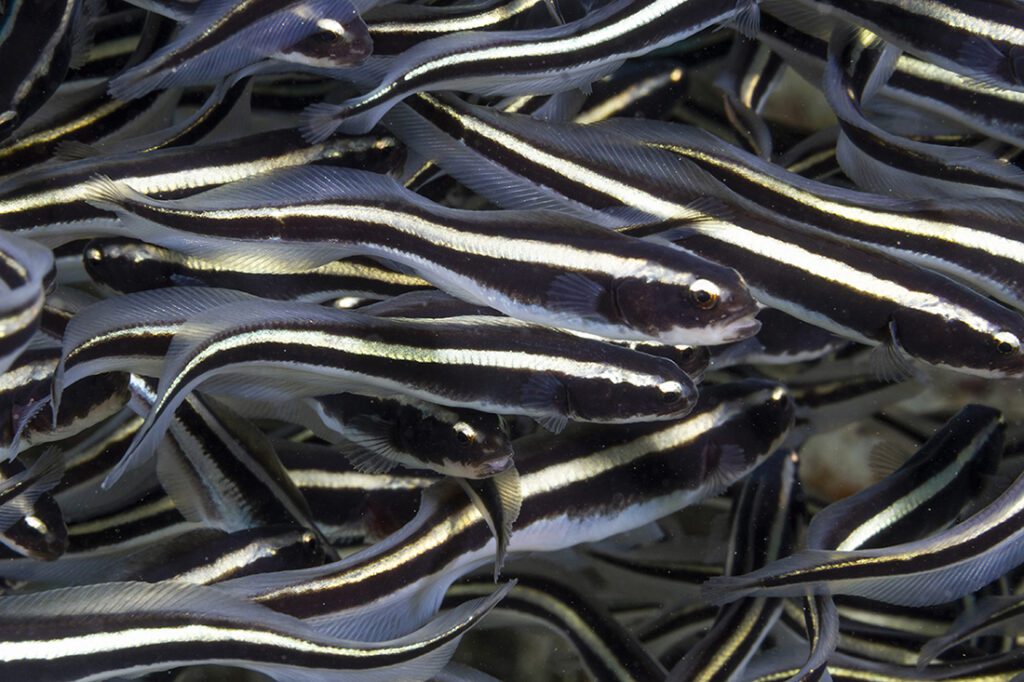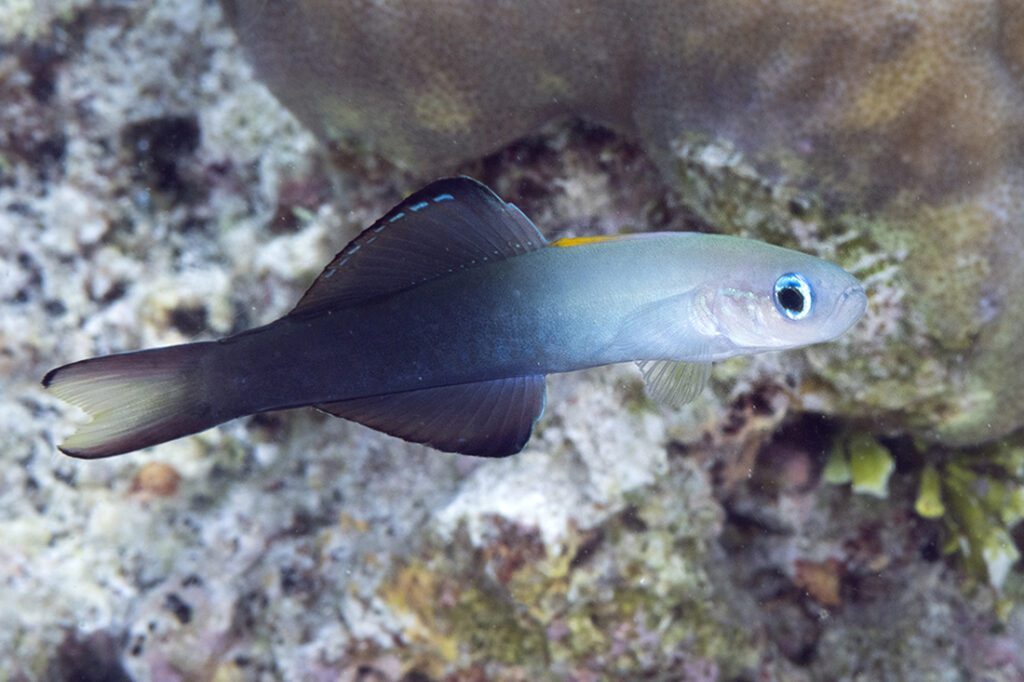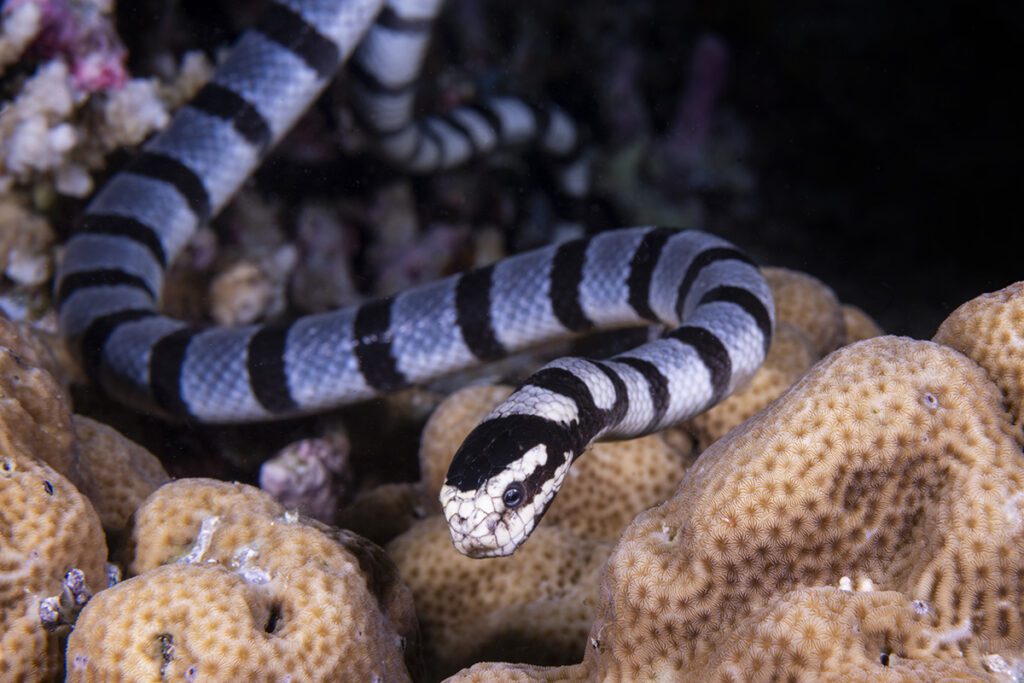Here is just a small sampling of what can be found on Wakatobi's House Reef. And as many divers and snorkelers who have experienced this underwater menagerie of marine life can attest, it is truly deserving on its title as World's Best Shore Dive.
Wakatobi's House Reef encompasses a vast area of seagrass meadows and shallow coral formations that lie between the beach and a precipitous coral rampart that plunges into the depths. Underwater photographers and critter watchers have been known to devote days and even weeks to exploring this expansive site, as it is home to a plethora of marine life. A complete listing of finds could fill a book, but for the sake of brevity, here are seven House Reef regulars that make for fascinating viewing and good photo ops.
Wakatobi's Odd Couple

A careful search of sand or rubble patches on the House Reef may reveal Wakatobi's own “Odd Couple.” The Randall's shrimp goby (Amblyeleotris randalli) is a burrow-dwelling fish that isn't big on housework. Unlike jawfish and other species that dig their own dwellings in the seabed, this clever little fish lets its roommate do work. When you happen across one of these distinctively striped fish, you'll likely see a small shrimp by its side. It's this crustacean that takes on the responsibility of building and maintaining their shared underground abode. In exchange for borrow maintenance, the near-blind shrimp enjoys the watchful protection of the keen-eyed goby, which maintains a peripatetic scan of the surroundings while the shrimp toils at debris removal.
Convict Labor
Some divers call them convict blennies (Pholidichthys leucotaenia), others say engineering gobies. You are most likely to encounter juveniles of this species, as they form schools numbering into the hundreds to swarm the reefs feeding on algae.

These youngsters might be mistaken for striped catfish, as they mimic the markings of this highly-toxic species in order to fool would-be predators. Adults are far more reclusive, spending most of their day peering from the mouth of the tunnels they excavate in the sand – hence the engineering reference. If you do happen to see an adult emerge, you'll understand the convict appellation, as mature fish take on eel-like profiles with distinctive white stripes on a black background, much like classic prison apparel.
The Cleaning Con

The upper expanses of Wakatobi's House Reef are covered in cleaning stations where cleaner wrasse dance and dart about to attract customers. There's a built-in degree of trust involved when a reef predator pauses with jaws agape, allowing a phalanx of small fish and shrimp to swarm over its body and into the mouth to remove parasites, dead skin and troubling infections.
But there is one devious denizen of the reefs that exploits the ethos of the cleaning station.

The blue-striped fangblenny (Plagiotremus rhinorhynchos) mimics the appearance and behavior of a juvenile bluestreak cleaner wrasse. But instead of picking parasites, this fangblenny takes a bite of flesh. This fish’s namesake fangs can dispense a pain-numbing venom containing morphine-like opioids that keep the victim from feeling the nip.
A Star Is Born
Hollywood made a star out of a small bright-blue fish named Dory. You can find her real-world counterpart on Wakatobi's House Reef, though you might be as confused as the cartoon character when it comes to names. The palette surgeonfish (Paracanthurus hepatus) as goes by the name regal blue tang, flagtail surgeonfish, and letter-six fish just a few out of the nearly dozen names this fish has been given known.

By any name, there's no mistaking the distinctive indigo and navy-blue color pattern sported by adults of the species. Equally iconic as its coloration is this surgeonfish's pointed, snout-like nose, small mouth and dainty teeth. This diminutive dental work is used to dislodge small bits of algae from corals and rocks, giving Dori's real-life relatives an important role in keeping corals free from algal overgrowth.
Claws of Fury

Their alien-like visage and iridescent stalk-set eyes make mantis shrimp a macro photo favorite. Most famous is the colorful peacock mantis, which can strike its prey with hammer blows that pack a punch equivalent to a 22-caliber bullet. But these lethal smashers aren't the only stomatopods prowling the House Reef. There's another member of the mantis clan that attacks with equal ferocity, and it's a slasher. Rather than smash open hard-shelled prey, the spearing mantis shrimp impales fish and other soft-bodied creatures with a lightning-fast deployment of its barb-tipped appendages.
Hiding In Plain Sight

The big blue octopus (Octopus cyanea), also known as the day octopus for their diurnal (daytime) behavior is a fan favorite among snorkelers and divers. And while exposing its soft and unprotected flesh to the light of day might seem a risky practice, this octopus has a plan: you can't eat what you can't see. While most all have a talent for visual deception, the day octopus is particularly adept at camouflage, able to change both the color and texture of it's skin in short order in a near-perfect match of its surroundings. This ability serves both to foil would-be predators and to conceal the octopus from its own victims. Observers have recorded day octopuses changing their appearance more than 100 times over the course of a few hours.
Grazers and Munchers

Turtle sightings are almost guaranteed on Wakatobi's House Reef, and there are two species you're most likely to encounter. Young green turtles foraging in the grass beds close to shore, chasing after jellyfish and using their beaks to dredge the seabed in search of small crustaceans and invertebrates.

Later in life, they'll switch to a vegetarian diet and graze on the sea grasses themselves. Green sea turtles play an important role in the health of the seagrass ecosystem because they nibble on the upper parts of grasses without disturbing the plant’s roots, which serves to improve the health and growth of the seagrass beds.

Move out onto the reef slope and you're more likely to run across a hawksbill turtle. Hawksbills enjoy a more varied diet than their vegetarian cousins, and will munch on a mixed menu of sponges, anemones, algae, squid and shrimp. They often forage around rock piles, using their narrow heads and beak-like jaws to reach into nooks and crannies.
Dartfish Trifecta
Sporting a dazzling range of rainbow hues, dartfish are among the most colorful finds on Wakatobi reefs. But fish waters and photographers who approach too aggressively will soon discover the namesake trait of these easily-spooked bottom dwellers. At the first hint of trouble, dartfish will pop back into the borrows they excavate in sand or rubble seabeds.
Dartfish watchers have a trio of options at Wakatobi. The first is the Two-tone Dartfish (Ptereleotris evides) are typically found on shallow reefs, making them an ideal find for snorkelers. These fish are among the largest species of dartfish, growing to lengths of up to 6 inches.

Divers who venture into middle depths of 6 to 15 meters can look for the fire dartfish (Nemateleotris magnifica), which are often found in pairs, and sport a distinctive flame-like coloration from the mid-section to the tail.

Deeper still are the decorated dartfish (Nemateleotris decora) which favor the sand-covered shelves and gullies on reef slopes at depths from 15 to 30 meters.

Luxurious Lashes

There's a stealthy hunter living on the reefs of Wakatobi, but most divers will swim right past this fish without noticing its presence. Like their namesake reptile, the crocodilefish is an ambush predator that spends most of its time lying motionless on a reef outcropping, waiting patiently for a meal to swim within range of a well-timed lunge. These fish are masters of camouflage and can adapt their body’s coloration and patterning to match their surroundings.

Crocodilefish also overcome one of the more common giveaways that plague stealth hunters — the eyes. To conceal their keen-orbed countenance, these fish grow long, lash-like growths known as lappets. The irregular, lacy shapes of these lappet growths help to break up the dark, reflective contours of the eyes, which might otherwise alert potential prey to this predator's presence.
I Really Don’t Bite
Though often seen on some dive sites at Wakatobi, one of the most lethal hunters in the water isn't actually a reef dweller. Banded sea kraits are actually air-breathing reptiles that live ashore and make breath-holding hunts among the corals and seagrass beds. A sea krait can remain underwater for up to a half hour, when is plenty of time to locate prey and administer a lethally paralyzing bite.

The venom of a sea krait is ten times more powerful than a cobra's, but divers have little to fear. These snakes aren't aggressive — though it would be extremely unwise to poke a finger too close in a threatening manner. Wakatobi is also home to an imposter. Banded snake eels display the same distinct white-and-black bands of the sea krait, counting on this visual misdirection to fool would-be predators. A closer look reveals subtle differences, as the krait’s body is more rounded, and it has a small, blunted head.
Wakatobi Dive Resort, home to Indonesia’s Finest Coral Reefs
Wakatobi Dive Resort is situated in Southeast Sulawesi, Indonesia, in the heart of the coral triangle. Known for its magnificent and highly protected coral reefs – from its famous House Reef and 42 plus surrounding named dive sites – this idyllic island paradise, located 750 km east Bali, is easily accessible through the resort’s private guest flight.
To go directly to the Inquire page for booking at Wakatobi Click Here









Great article and photos!